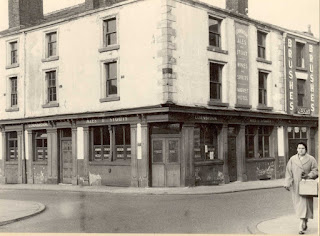News of the £1 billion ‘Bolton Regeneration’ last weekend oddly made no mention of the Church Wharf Development which was put forward by Bolton Council as long ago as 2006. This plan, which was to develop the area of Bolton bounded by Manor Street, Folds Road and the River Croal, was put out to a ‘beauty contest’ in 2007 which was won by developers Bluemantle and Ask Developers. They proposed a £210 million “vibrant leisure zone providing restaurant and café bar units creating a destination for diners throughout the day and evening” as well as a “5/6 screen town centre cinema” and “a 126 bedroom hotel.” Outline planning permission was granted in September 2008 but the following month Ask and Bluemantle were asking for a bailout from the taxpayer and by March of last year the two were hoping to receive up to £10 million of public funds from the North West Regional Development Agency; but this was knocked back last summer.
As this photo shows looking down Brown Street the area doesn’t look that great at the moment so it was hardly surprising the council wanted to spruce it up, though it’s a sign of late ‘noughties’ thinking that the leisure industry was being looked at to replace the largely blue-collar industries in the area.
Diamond Glass Works occupy the old Well Street Mission building, Bolton Thai Boxing is further up Well Street and there are a few motor mechanics in the area, but have a look at the above photograph from 1937 [copyright Bolton Council]; taken from almost exactly the same spot as the photo above, there seems to be a vibrant community with shops, houses and a pub, the Grapes Hotel.
The area began to develop in the late-eighteenth century but the Grapes’ building has its own place in Bolton’s history, though from the days before its conversion into a public house. In 1818 a series of meetings were held at the premises of Robert Barlow, a wine and spirits merchant on Water Street. As a result, Bolton’s first bank – Hardcastle, Cross & Co - was set up in Mr Barlow’s premises, although by 1822 it was trading from a building in Market Street. [1]
Mr Barlow’s old premises became a beer house in the middle of the eighteenth century. It was situated on the corner of Water Street and Brown Street and in the 2011 photograph above it was roughly where the grass juts out opposite the first lamp post on the right.
This image, from 1885 and taken from Brown Street’s junction with Manor Street shows the Grapes in the distance with Taylor’s oil and paint store where the dental repair place now is, and the Dog & Partridge next door to that.
The Grapes was a Magee’s pub when it closed in 1952 at the start of a series of clearances that turned this community almost into a forgotten wasteland. In the early seventies the construction of St Peters Way and the Folds Road car park cut off the area from Mill Hill leaving Brown Street as pretty much the only way in or out.
It’s hard to say whether the Church Wharf development is dead now that the tax payer won’t be subsidising the project. It’s all gone quiet now, and maybe that’s to the relief of the businesses that survive in the area. Maybe we shouldn’t hold our breath.
[1] Royal Bank Of Scotland Heritage Archives.
Illicit Brewing
-
[image: A Home Ales Home Brewed label featuring a drawing of a bearded man
with a club.]
After 1880, the rules on domestic brewing changed. The most notab...
7 hours ago

















